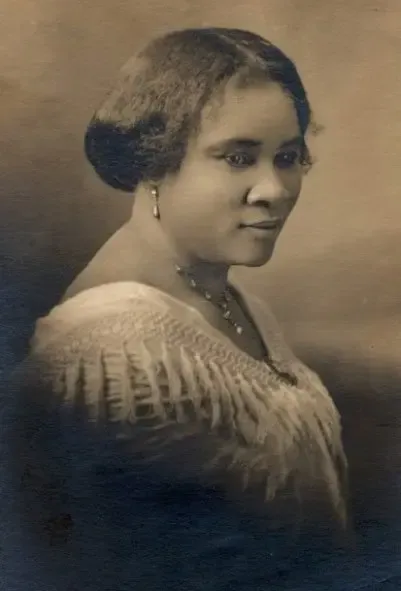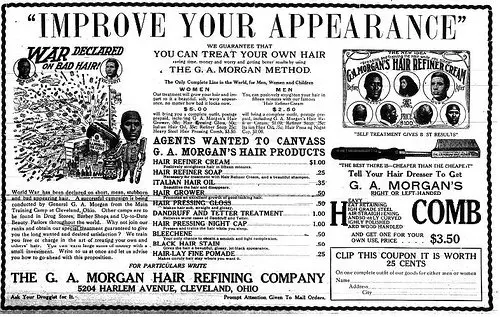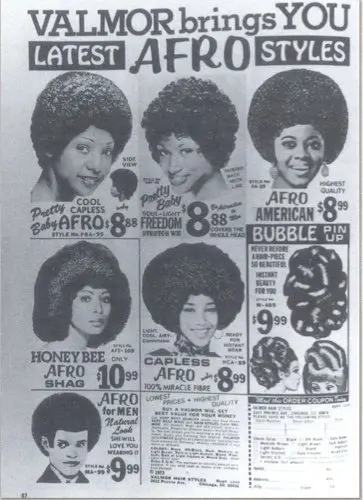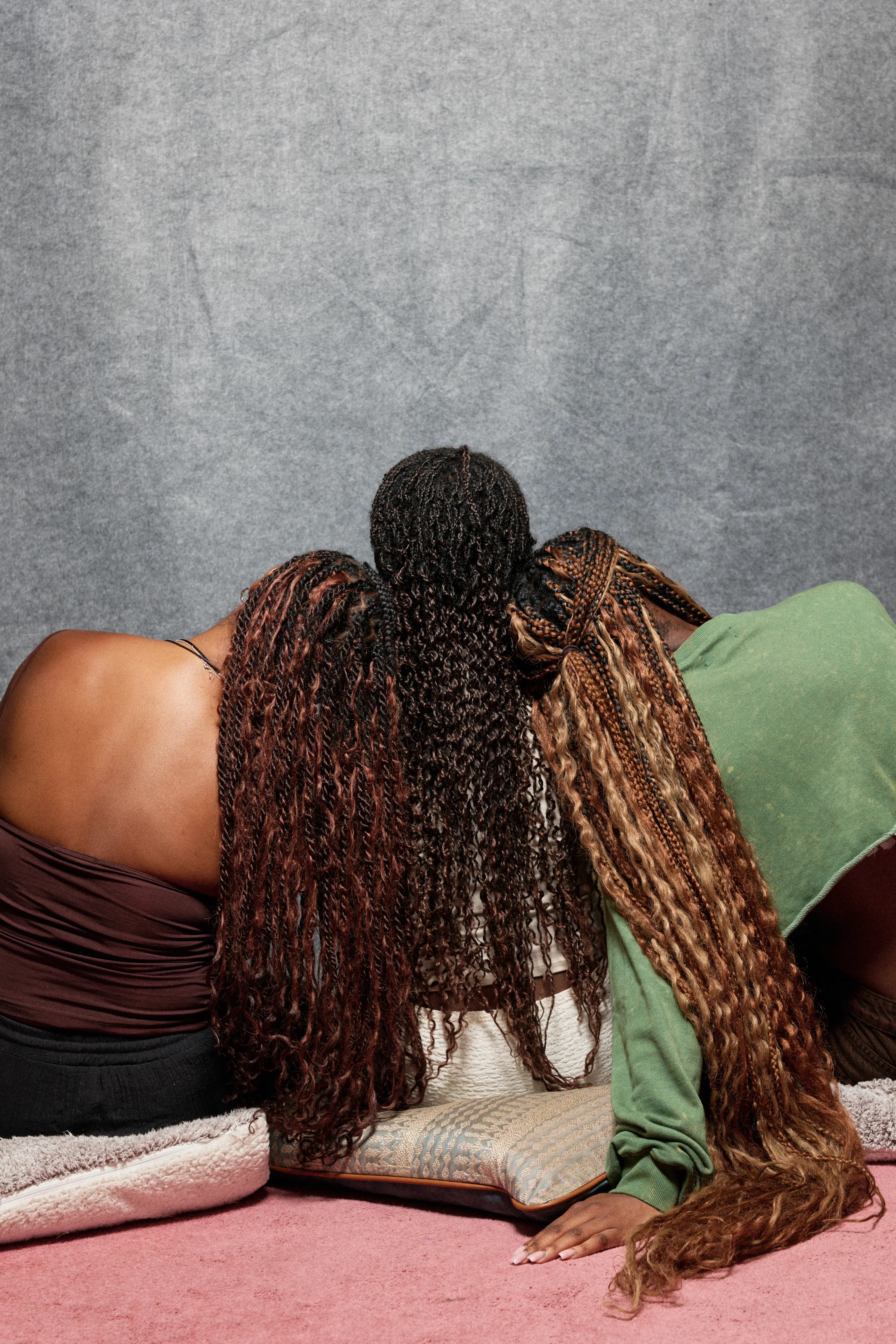
A Short History Of
Hair Discrimination


Photograph of Kenyan hair braiding, date and origin unknown.
Traditional Status
Afro-textured hair and hairstyles have always been an important symbol of wealth, identity, family, heritage, age, tribe, religion, and social rank, as well as a visual language. Hairstyling was a meaningful social activity, where time spent on intricate styles and hair care was highly valued. It was an intimate activity, where bonds were built and knowledge was shared within communities. Connection to these traditions was ruptured by the advent of the transatlantic slave trade and colonialism.


Slavery & Colonialism
Early discrimination of Black hair began in the fifteenth-century. European colonists framed themselves as ‘white saviours’ on a ‘civilising mission’ and classified Afro-textured hair as closer to fur or wool than human hair, using Black hair as validation for dehumanisation, enslavement, and exploitation. Slave traders regularly shaved the heads of captives, and the term dreadlocks originally derives from slave traders; descriptions of Afro-textured hair as “dreadful” after it had naturally formed into locs during the Middle Passage. Negative internalised perceptions about natural Black hair exist today because of centuries of trauma.

Zulu hairstyles in South Africa from The Illustrated London News, 1879


Portrait of slavery in North Carolina from The Illustrated London News, 1863.
Colourism & Texturism
During slavery there was a strict caste system that separated Black slaves by skin tone and hair texture. Lighter-skinned slaves with less kinky hair, typically due to nonconsensual sexual relations with slave-owners, received better treatment. This hierarchy of hair types was based on European standards of beauty, and fed into the creation of social structures based on skin tone (known as colourism) and hair texture (known as texturism) that continue to impact the lives of Black people throughout the diaspora today.


Attitudes Post-Slavery
Derogatory attitudes towards natural Black hair continued after the abolition of slavery. Global definitions of beauty have long been determined by whiteness, with Western European features associated with “civility” and “respectability”. As a result, Black people began to use hot combs and harsh chemicals to straighten or “tame” hair in ways that mimicked European textures. These industries became so large that ‘self-made’ Black millionaires like Madam CJ Walker built empires selling hair relaxants to Black people trying to achieve white beauty standards. Straighter hair and looser curls became synonymous with “good hair” and were understood to be a requirement for accessing social and career opportunities, perpetuating the idea that natural texture hair was unkempt, unacceptable, and unprofessional. These racist beauty standards were normalised around the world and still remain in place today.

Madam C.J. Walker, circa 1914


G. A. Morgan Hair Refining Company advertisement for hair relaxer, 1913
Racialised Barrier
Even after the abolishment of slavery, barriers to advancement like “The Comb Test” were used in the US to enforce the idea that Afro-textured hair was not socially acceptable. An organisation would hang a fine-tooth comb outside its door, indicating that if a visitor’s hair could not be easily combed, they were not welcome to enter. During Apartheid, Black South Africans were forced to participate in “The Pencil Test” to see if they could hold a pencil in their hair while they shook their head. If the pencil dropped to the floor, the person would be classified as white. If the pencil remained in their hair, they were classified as Black, subjected to segregation, and forbidden from accessing the same privileges. While these tests faded out of use, hair discrimination did not.

Black Power & Rastafarianism
In the 1960s, the Black Power movement declared that “Black is beautiful” and that embracing Blackness was a radical act of self-love. During the Civil Rights Movement, the Afro became a symbol of pride and solidarity within Black diasporic communities. For some, the way hair was worn became a political statement - a purposeful act of defiance against the beauty standards that had degraded Black hair for hundreds of years. Although Rastafarianism originally developed in Jamaica in the 1930s, the faith also became popular around the world at this time. Rastafarians wear their hair in dreadlocks for Biblical and spiritual reasons, and the success of reggae music introduced locs to the mainstream.

Valmor advertisement for Black hairstyles, early 1970s


Natural Hair Movement
The early 2000s saw the growth of the Natural Hair Movement, focused on encouraging Black people to celebrate the natural characteristics of our kinky, curly, hair texture. This came with growing evidence that hair relaxers can cause serious and permanent damage. The growth of the internet, and more recently social media, allowed the natural hair community to connect across the world and share encouragement, advice, product reviews, hairstyle tutorials and much more. The movement saw the beginning of reclaiming the word “nappy” in the United States, which had previously been intimately tied to slavery as Black hair was likened to the tuft of a cotton plant called a “nap”. This new enthusiasm for natural hair caused a significant rise in products for natural Black hair care, and the industry is now worth an estimated $2.5 billion in the US alone. The foundational principle of the Natural Hair Movement is that the hair curling from our heads is innately beautiful and should be free to exist that way without policing or prejudice. So, too, should we be free to choose any other hairstyle without shame or judgement.
Halo Campaign

More than ever, Black people are asserting autonomy over our hairstyling decisions, reconnecting with our heritage, and reclaiming what it means to be beautiful. But Black hair still remains a battleground in the UK, with instances of unfair treatment in schools, in workplaces, and on the street. Together, it’s time to end hair discrimination for good.



Case Studies
Schools
Across the country Black and mixed-race pupils are still being excluded because our hair is too short, too long, too big or too full.
Ruby Williams
At the age of 14, Ruby Williams was repeatedly sent home from The Urswick School in London for having an afro. She was told by that her hair breached school policy, which stated that “afro hair must be of reasonable size and length” and the Head Teacher told her that her hair was “too big”. She was awarded a settlement of £8,500 after her family took legal action with the backing of the Equality and Human Rights Commission. The school has now removed the policy from their website but refuses to accept that it had discriminated, “even unintentionally” against Ruby.
Chikayzsea Flanders
In 2017, 12-year-old Chikayzea Flanders was told he would have to cut off his dreadlocks or face suspension from Fulham Boys School. The family took the school to court, calling the demand an attack on their Rastafarian religion. They reached an agreement with the school, which paid a settlement and covered the cost of the lawsuit.
Josiah Sharpe
In 2019, five-year-old Josiah Sharpe was banned from the playground at break-times and eventually sent home from his school in Birmingham due to his “extreme” fade haircut. His mother, who is a hairdresser, offered to come into the school and give a presentation about Afro hair but the Head Teacher refused.

Workplaces
Hair discrimination in the workplace has been illustrated by high profile cases that garnered media attention.
Lara Odoffin
In 2015, Lara Odoffin, a Bournemouth University graduate, had her job offer withdrawn because she wore her hair in braids. She shared an email from the prospective employer on Facebook which said: “Unfortunately we cannot accept braids - it is simply part of the uniform and grooming requirements we get from our clients. If you are unable to take them out I unfortunately won’t be able to offer you any work.
Simone Powderly
In November 2014, blogger and model Simone Powderly was asked by a “luxury recruitment agency” to remove her braids or “risk missing out on a job opportunity.” When applying to get on the books of Elite Associates, she was told that she was successful in the group assessment but was asked if she could “take out her hair out in time for the interview” because “high-end brands like a more natural look?”
Harrod’s Applicant
In 2017, a Black woman claimed she was told by an external agency to chemically straighten her hair if she wanted a job at the high-end department store Harrods. Speaking in an evidence session for the Petitions and Women and Equalities Select Committees in Parliament, she said: “I have worked in retail before, notably at Harrods. They are really quite bad and I ended up leaving as a result of that.”